Global Marketing (IMM)
The most important factors to consider for globalization:
Ethical
Practical
Entrepreneurial
Political
Economical
From Local to Global, the big questions are Why? Where? How?
Is it really so difficult and complex?
Yes! A company needs to consider strict implementation, intercultural awareness, creativity, good analytical skills and risk management.
5 steps to go global – the structure of this series

In SME (small medium enterprises) this is informal; in larger organizations it is often more systematized.
Learning objectives
Understand globalization
Overview the 5 steps to go global
Explain how internationalization can be initiated
Describe and clarify different internationalization theories
Discuss a real life case
Step 1: Decision whether to internationalize
Global marketing in the firm
Nine strategic windows
Global marketing concept
Initiation of internationalization
Internationalization motives
Internationalization barriers/ risks
Internationalization theories
The decision to globalize is not a simple solution, it’s also a matter of choice: how to best use my resources?
Should I focus on the local market?
When should I start looking at other markets?
Stay at home or go abroad – The nine strategic windows
Solberg (1997, p.11) | Industry globalism | |||
Local | Potentially global | global | ||
Preparedness for internationalization | Mature | 3. Enter new business | 6. Prepare for globalization | 9. Strengthen your global position |
Adolescent | 2. Consolidate your local markets | 5. Consider expansion in international markets | 8. Seek global alliances | |
Immature | 1. Stay at home | 4. Seek niches in international markets | 7. Prepare for a buyout | |
Industry globalism- international competitive structure within an industry – high globalism there are many interdependencies between markets, customers and suppliers, industry dominated by few large powerful players, the other end represents multidomestic market environment (markets independently of another).
Very global: PCs, IT, Movies, aircrafts
More local: hairdressing, foods and dairies
Preparedness for intern. – determined by firm’s ability to carry out strategies in int. Marketplace
personal skills (language, cultural sensitivity), managers international experience and financial resources. If limited international experience and weak position in home market- rather stay at home. If in really global industry- sell advanced high-tech components to industrial companies with global network (for example).
Local or Global or… “Glocal”
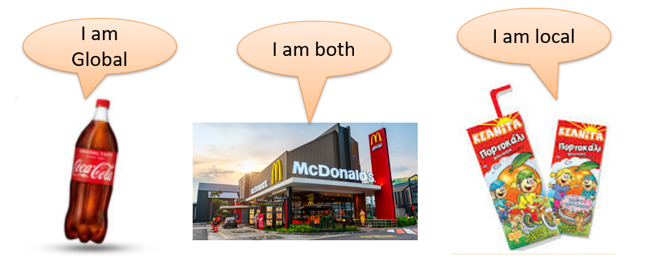
For example, Coca Cola is the same everywhere, McDonalds have stores everywhere but each country has their own management and food (it is adapted to the place) while the Russian brand is focused only on its country.
Global marketing concept
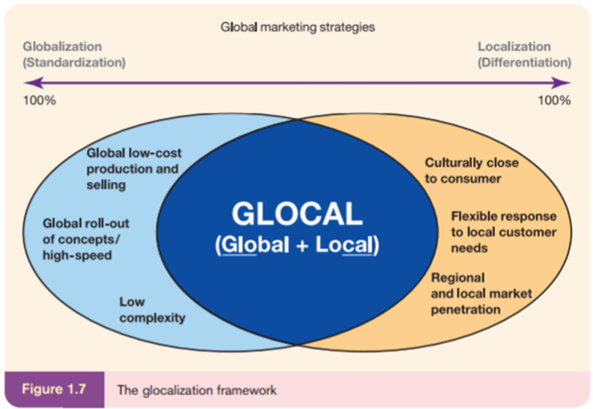
Think globally but act locally – dynamic interdependence between headquarters and subsidiaries. Ensure local flexibility while exploiting the benefits of global integration and efficiencies.
Glocalization – knowledge management really important- continuous learning from experiences. Keep track of valuable capabilities used in one market that could be used elsewhere.
Motivation to go international
Are you motivated to go international? – One can ask themselves, ‘Do I really need to go international?’.
Proactive motives | Reactive motives |
Profit and growth goals | Competitive pressures |
Managerial urge | Domestic market: small and saturated |
Technology competence | Overproduction/ excess capacity |
Foreign market opportunities | Unsolicited foreign orders |
Economies of scale | Extended sales of seasonal products |
Tax benefits | Proximity to international customers/ psychological distance |
Perceived profitability of exporting (often not actual) – if no experience then perceived and actual can differ quite a lot
Managerial urge- part of an international firm, desire to travel, depending on the size of the firm this can be one individual or a decision-making team, cultural socialization of managers (if they have been abroad or travelling- they may be more internationally minded).
Unique- if a product different firm may believe that it has more chance (again different to the actual state)
Foreign market opportunities/ info: certain markets might be attractive because of their size or if the company has particular promising information about the market
Economies of scale- learning curve- decrease production costs or learn from another international market – fixed costs (administration, facilities, equipment, R&D) spread over more units
Tax benefits- many companies in NL benefit from good taxing here, lower costs in foreign markets, or accumulate higher profit- however WTO punish foreign producers for selling products on local markets at very low prices in order to protect local producers.
Reactive motives
Competitive pressure- fear of losing the domestic market because other companies have economies of scale, coca cola went international and that also made Pepsi go
If saturated in the domestic market- you might have to move international – US car manufacturers going international
Overproducing/ excess capacity – equipment for production not really producing at capacity- because demand domestically is not there anymore or changing, overseas opportunities might be searched
The company gets orders from foreign markets and that can be stimulant to also start selling in that market
For example, producing agricultural machinery in Europe with primarily spring months of the year- more stable demand they also sell in the southern hemisphere
Proximity- example of Germany selling to Switzerland/ Austria or NL and GER
Economies of scale
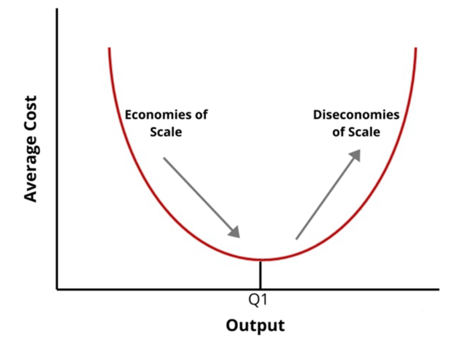
Economies of scope
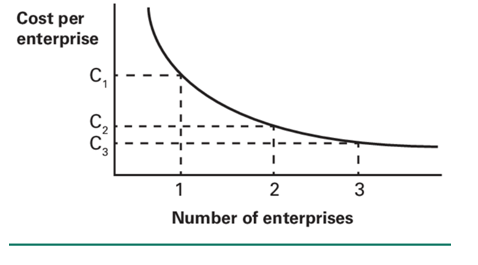
Internationalization triggers (agents)
The motive might be there, but a trigger is needed
Someone or something within or outside the firm (change agents) must initiate the process and carry it through to implementation- internationalization triggers
Often not one isolated factor but a combination of factors
Internal triggers | External triggers |
Perceptive management/ personal networks | Market demand |
Specific internal event | Network partners |
Importing as inward internationalization | Competing firms |
Outside experts |
Become knowledgeable about markets – a certain person that pushes the internationalization
Overproduction or a reduction in domestic market size can serve as an event or new information about current product uses.
A natural way of development could be first to start importing from abroad and that way start the internationalization process
External trigger- can be market demand- if growing market they might also all of a sudden require another product
Network partners- can be key internationalization sources, distributors, trade associations, research institutes or universities.
Competing firms entering a market can also be an agent
Government, export agents, chambers of commerce or banks- internationalization process in the horse industry for example because of substitutes to go abroad/Holland horse nation…
Can I do this? Internationalization barriers
Insufficient finances
Insufficient knowledge
Lack of foreign market connections
Lack of export commitment
Lack of capital to finance expansion into foreign markets
Lack of productive capacity to dedicate to foreign markets
Lack of foreign channels of distribution
Management emphasis on developing domestic markets
Cost escalation due to high export manufacturing, distribution and financing expenditures
Are there any risks?
General market risks
Competition from other firms in foreign markets
Language and cultural differences
Difficulties in finding the right distributor
Commercial risks
Exchange rate fluctuations
Delays/ and or damage in the export shipment
Political risks
Governmental restrictions, export policies, exchange controls, tax incentives, ….
Born global
Born global challenge traditional theories (late starter or international among others)
Increasing role of niche markets, advances in process/ technology production, flexibility of SMEs/ born global, global networks help rise of born global
Deciding which markets to enter
Learning goals
Understand how market research links to decision making
Understand how int. political and economic environment can create market opportunities
Know how companies select international markets
Discuss real life cases
How are we going to approach this subject
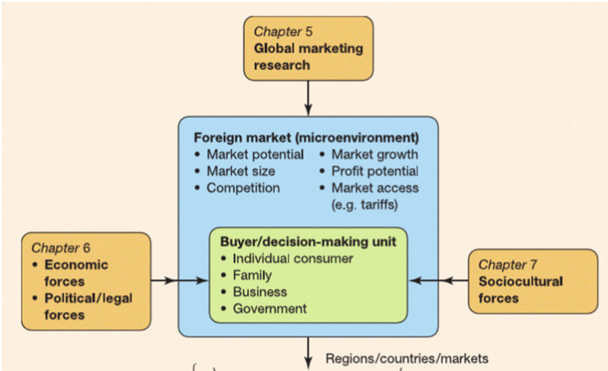 The tools – Global Marketing
The tools – Global Marketing
The forces - Sociocultural forces, Economic forces and Political/legal forces
 And this figure shows the selection process
And this figure shows the selection process
Research Vs Intuition Vs Guessing
(Business) Intuition: the ability to understand something instinctively, without the need for conscious reasoning.
Guessing: to give an answer to a particular question when you do not have all the facts and so cannot be certain if you are correct.
Research: a detailed study of a subject, especially in order to discover (new) information or reach a (new) understanding
Educated guess: a guess that is made using judgment and a particular level of knowledge and is therefore more likely to be correct
Educated intuition: the product of intuition and background knowledge (that is a result of research)
Everything starts with research – or at least it should…
 Political/ legal environment
Political/ legal environment
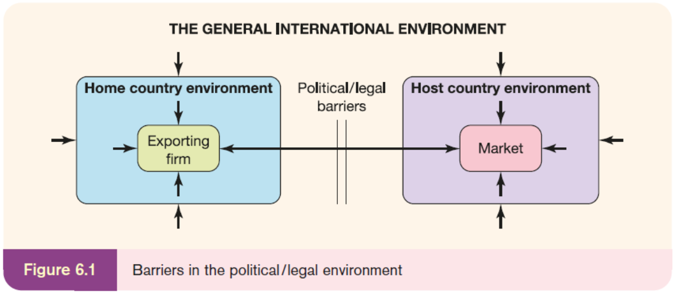
Political risks, trade barriers (tariff or non-tariff barriers)
Economic environment
Economic development results from one of three types of economic activity
Primary – agriculture and extractive processes
Secondary- manufacturing activities
Tertiary- services
Factors to consider: exchange rates, law of one price (BigMac currencies – how much is money worth if BigMac was same price), Income (GNP), Unions (regional integration), per capita income, structure of consumption
Cultural environment
The visible daily behaviour – Tier 1 of the iceberg - Tip
Body language, clothing, lifestyle, drinking & eating habits
Values and social morals – Tier 2 of the iceberg
Family values, sex roles, friendship patterns
Basic cultural assumptions - Tier 3 of the iceberg - Deep
National identity, ethnic culture, religion
Hofstede’s model
Geert Hofstede, assisted by others, came up with six basic issues that society needs to come to term with in order to organize itself. These are called dimensions of culture.
Assesses countries on different dimensions
Power distance
Individualism
Masculinity
Uncertainty Avoidance
Long term Orientation
Indulgence
Erin Meyer’s model
Assesses countries on different dimensions
Communicating
Evaluating & feedback
Persuasion
Respect
Decision making
Trust
Disagreeing
Time perceptions
International selection process
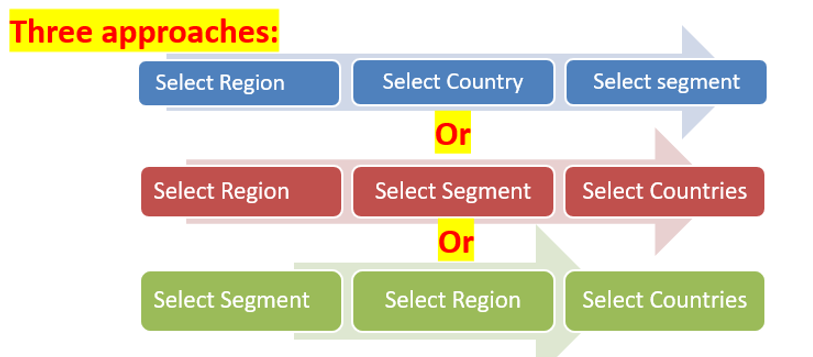
How do we select the country?
Characteristics of the firm (STRENGTHS, WEAKNESSES) alongside Characteristics of the market/ country environment (PEST, PORTER’S 5 F), we decide which parameters are important for our decision.
e.g.
If we are a new and small company, then existing competition is very important (more than if we were a large and established company)
If we have a lot of experience in foreign markets, then geographical distance from the base is less important
Etc
How do we put the parameters together?
Parameter | Weight (%) | Score of Option 1 | Score of Option 2 | Score of Option 3 |
Location | 33 | 7*33%=2,31 | 5=1,65 | |
Reviews | 33 | 7*33%=2,31 | 7=2,31 | |
Program | 34 | 7*34%=2,38 | 6=2,04 | |
+ | ||||
+ | ||||
TOTAL: | 100% | 7 | 6 |
Parameters
You need to choose the parameters that you think are most relevant to your decision. For every decision, it can be a different set of parameters
For example, when renting a house: location, size, and rent are some important parameters
For example, when deciding on a country to enter: market size, cultural differences, currency, and political risks are relevant
Weight
In case not all parameters have the same importance for you, then you can adjust the weight according to this
In the house renting example, the price might be more important than the age of the house, so the price would get a higher % than the age
In the country selection example, market size might be more relevant than the political situation, then it gets a higher % than the political situation
Of course, all % of parameters have to be added to 100.
Scores
For each option, and each parameter you need to give one score
Scoring can be in different ranges. For example from -2 to +2, or from 0 to 10.
In any case, the meaning of scoring should be transparent. It should be clear (with an extra table or a comment in the table).
In the example of home rental, a scoring for location could be: -2: more than 1.5hours from work/ -1: 1hour from work/ 0: 45min from work/ +1: 30min from work/ +1: 15min from work/ +2
Total
Based on the weight and the score, the multiplications are done for each parameter, and then this is added to the bottom in order to get the total score.
The option with the highest score is obviously the preferred one.
The general idea of the table is to systemize collected information in order to make one clear decision.
Before doing the above analysis in the table, we can also have some knock-off criteria. For example:
We don’t want to go to countries with corruption
We don’t want to go to countries without corruption
We don’t want to go to countries that are more than 4hour flight from the base
Etc
The end result could be:
One foreign country, different segments within that country
More than one foreign country, different segments within those countries
One specific segment, different countries
How to enter a new international market?
Different ways to do it. The decisions lie on a spectrum but the 3 main ways to enter a market are:
Internalized – hierarchical roles
In between – intermediate modes
Externalized – export modes
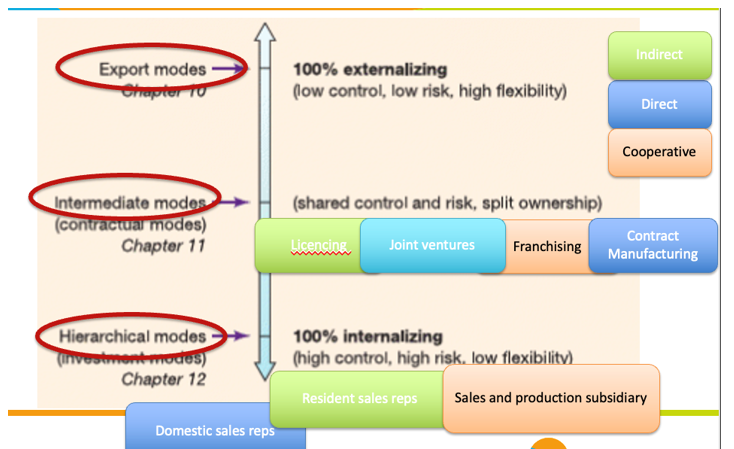
Hierarchical modes – used in big companies
Export modes – usually used in small companies
Differences between different modes:
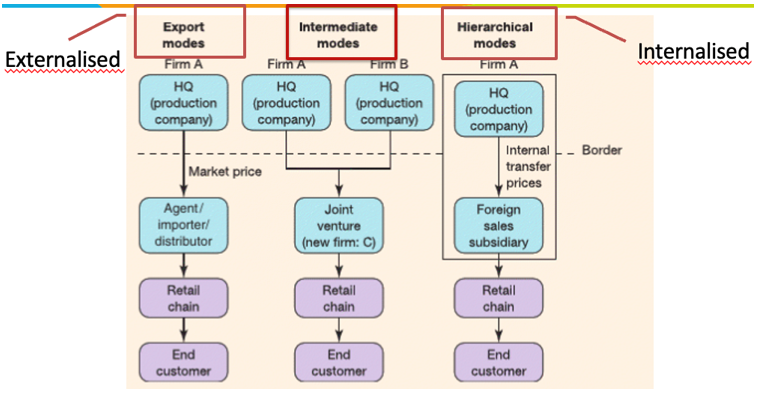
Export modes:
Direct – distributor, agent
Intermediate – contract manufacturing (for large items), licensing, joint ventures, franchising
Hierarchical modes – domestic sales reps (employees travelling to other parts to sell the product), resident sales reps (employees living in another country and selling the product there)
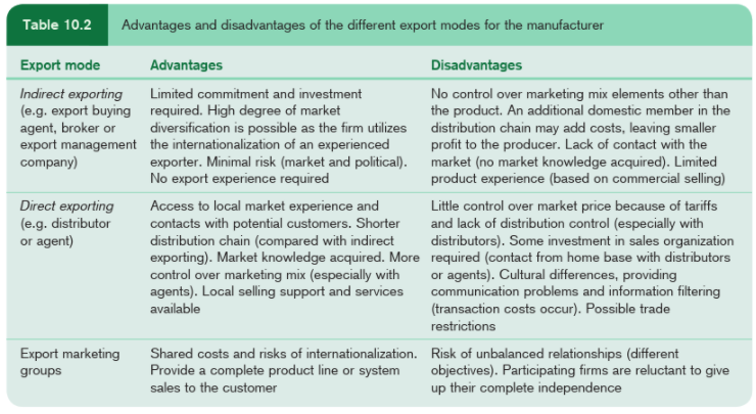
Intermediate modes:
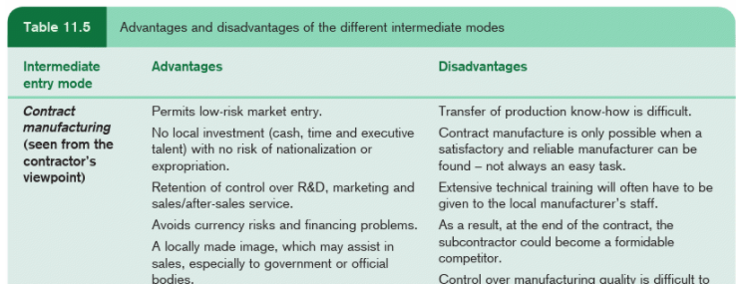
Hierarchical modes:
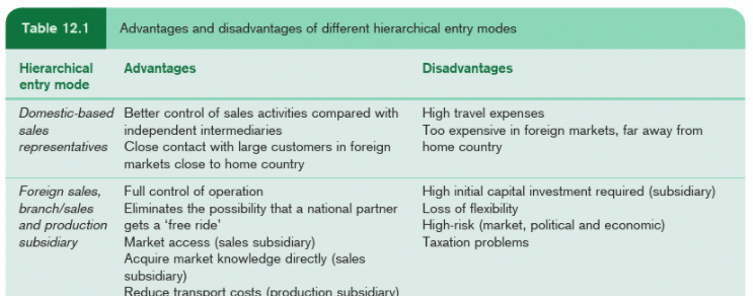
What parameters play a role in our decision?
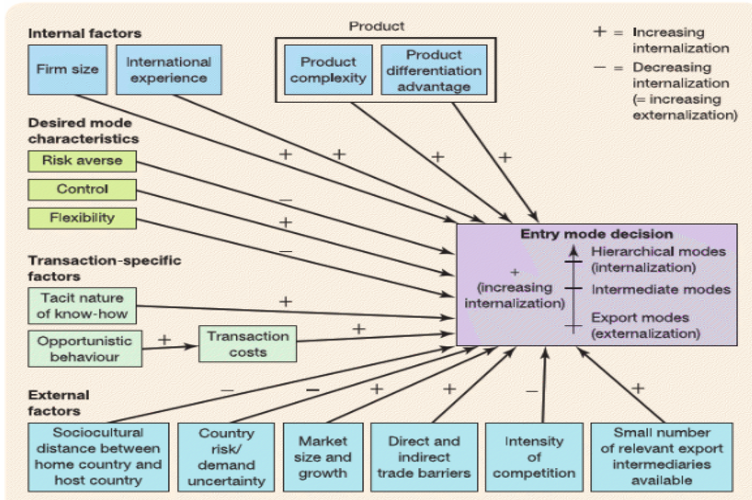
Designing the global marketing program:
The general approach
International perspective
Product
Pricing
Place
Promotion
1. The general approach
4P Marketing Mix – product, place, price, promotion
4+3 Marketing Mix - product, place, price, promotion, process, physical environment, people
Either strategy works, the 4P Marketing mix is for products while 4+3 Marketing Mix is usually for services.
2. International perspective
Adaptation vs standardisation
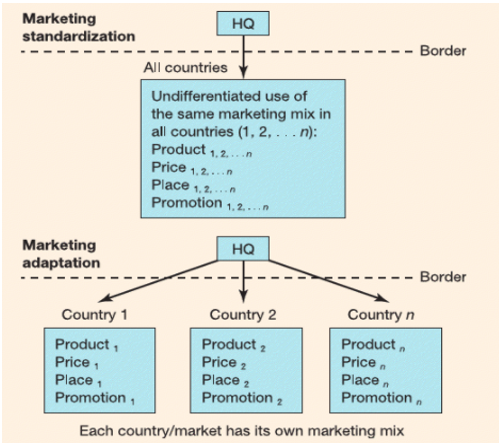
How to choose: Main factors favouring standardization versus adaptation
Factors favoring standardization | Factors favoring adaptation |
Economies of scale in R&D, production and marketing (experience curve effect) | Local environment-induced adaptation: sociocultural, economic and political differences (no experience curve effect) |
Global competition | Local competition |
Convergence of tastes and consumer needs (consumer preferences are homogeneous) | Variation in consumer needs (consumer needs are heterogeneous because of cultural differences) |
Centralized management of international operations (possible to transfer experience across borders) | Fragmented and decentralized management with independent country subsidiaries |
A standardized concept is used by competitors | An adapted concept is used by competitors |
High degree of transferability of competitive advantages from market to market | Low degree of transferability by competitive advantages from market to market |
Further issues: | Further issues: |
Easier communication, planning and control (through internet and mobile technology) | Legal issues – differences in tactical standards |
Stock cost reduction |
|
New products for the international market
| Product | |||
Standard | Adapt | New | ||
Promotion | Standard | Straight extension | Product adaptation | Product invention |
Adapt | Promotion adaptation | Dual adaptation | ||
3. Product - key concepts
Decide if you offer a product or a service; there are cases where both can be possible
3 Levels of a product - the core product, the actual product, and the augmented product
Product Life Cycle and International Product Life Cycle - identical
Positioning
Branding
How can it be a product, a service or both:

Dimensions of international product offer
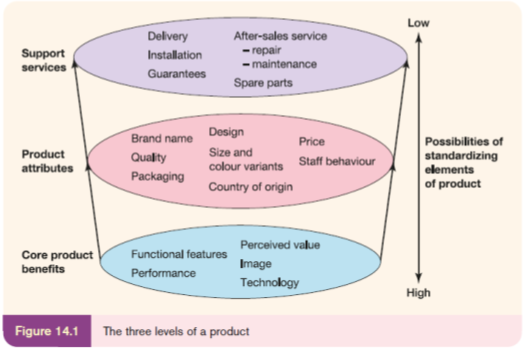
4. Pricing - key concepts
• Should we have one international price, or should we differentiate our prices? And how?
• Basic pricing strategies
• Currency issues
• Terms of sales and delivery (INCO terms)
• Terms of payments
International pricing decisions
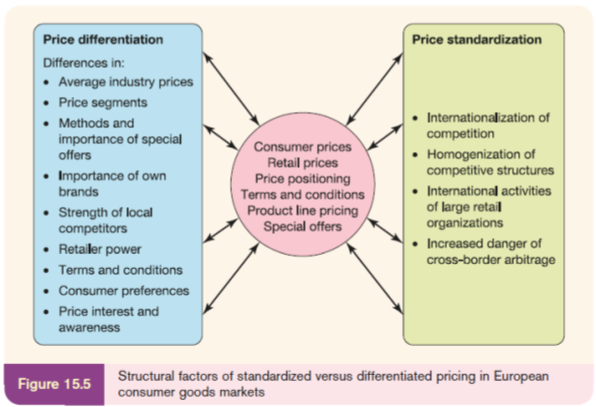
Pricing strategies
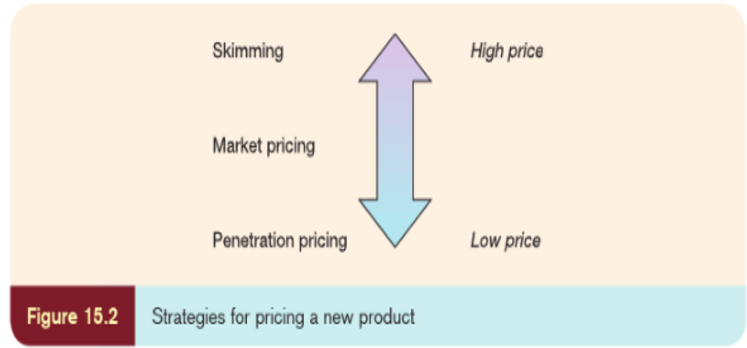 High prices to low prices are based on a spectrum. Skimming is more towards High price and Penetration pricing is towards Low price. Market pricing is a strategy that lies in between, and can be considered Medium price.
High prices to low prices are based on a spectrum. Skimming is more towards High price and Penetration pricing is towards Low price. Market pricing is a strategy that lies in between, and can be considered Medium price.
INCO Terms
Incoterms, widely used terms of sale, are a set of 11 internationally recognized rules which define the responsibilities of sellers and buyers. Incoterms specify who is responsible for paying for and managing the shipment, insurance, documentation, customs clearance, and other logistical activities.

Payment terms
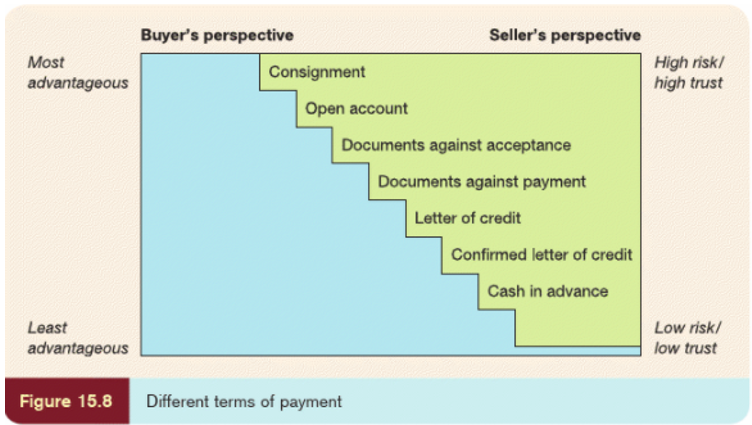 There are five primary methods of payment in international trade that range from most to least secure: cash in advance, letter of credit, documentary collection or draft, open account and consignment. Of course, the most secure method for the exporter is the least secure for the importer and vice versa.
There are five primary methods of payment in international trade that range from most to least secure: cash in advance, letter of credit, documentary collection or draft, open account and consignment. Of course, the most secure method for the exporter is the least secure for the importer and vice versa.
5. Place
A place can mean location, but also channel and distribution
Channel Characteristics:
Length
Coverage
Vertical Integration
Multi-channel distribution
Channel power distribution
How to decide:
Customer characteristics
Nature of product
Nature of demand
Competition
Legal issues/ Norms
Length:
Long chains (when selling internationally chains are usually longer) vs. short chains
The new trend is to keep the chains shorter
When you sell internationally, usually chains are longer
In the sense of the number of intermediates
New trend to keep chains shorter
Integration
Integration is a strategy for delivering a unified message across all the marketing channels your brand uses. It provides consistency wherever customers choose to interact with a company. Without an integrated marketing strategy, you risk delivering mixed messages or communicating in a disconnected voice.
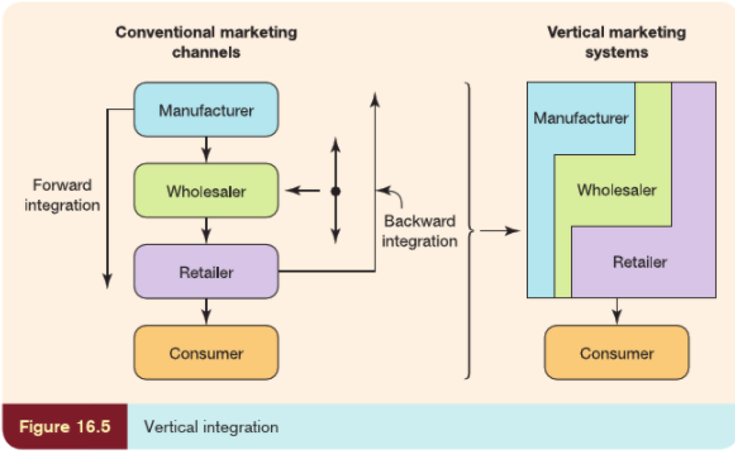
Multi-channel distribution
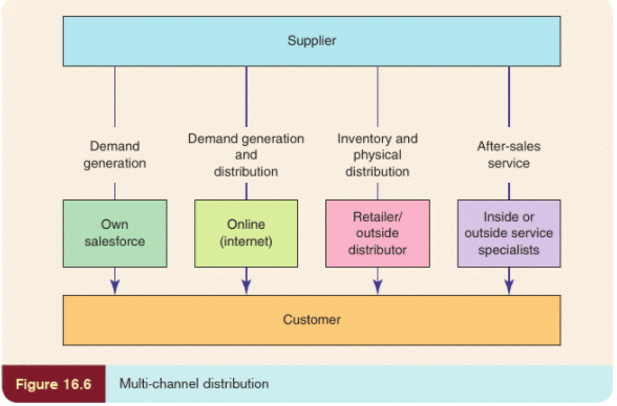
Channel Power Distribution

6. Promotion - key concepts
Communication tools
International advertising strategies
Implications of the Internet
Social media marketing
Developing a viral marketing campaign
Net Marketing Contribution (calculation)
Communication tools, beyond advertising
Communicating with your customers on a global scale is quite a challenge!
Advertising is the most obvious tool, but not the only one
Other tools: personal selling, exhibitions, sales promotions, (free) publicity, and direct marketing (including the Internet)
New and old communication tools

Whatever the context or the level, communication is always defined by: sender that conveys a message by a communication channel that will reach a receiver.
International strategy – more complicated!
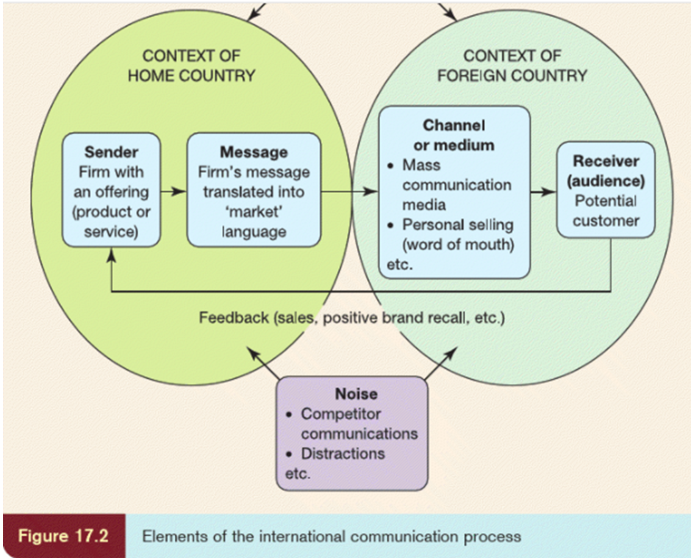
In the international setting, the sender is the same as the local setting, but everything else is/ can be different.
What level of standardisation?
Standardisation has many advantages:
economies of scale,
efficiency
BUT!
What about cultural differences?
Humour, Values, colours, historical background, connotations, metaphors, traditions…
The Internet as part of an international strategy
The Internet provides new possibilities and new opportunities
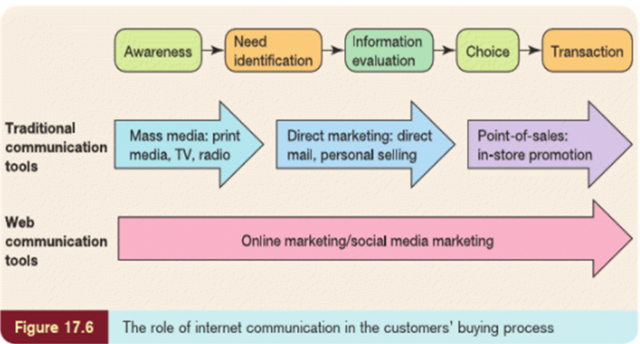
But…
As it is available to everybody, it is hard to be heard above the “noise”
Also, the most important channels are controlled by a handful of companies (Google, Facebook, Amazon, etc)
=> Never underestimate the importance of “traditional” channels
Nowadays, communication has the same idea but with different tools and different reach.
Social media facilitates communication in a transformative way

Implementation
We spent 5 weeks to decide whether, where and how
In reality, a company would spend months or even years deciding on these issues.
Research, planning, and internal negotiations will (or might) eventually lead to a plan
Now the plan needs to be implemented!
Planning Vs Implementation
They are both important!
We spent 5 weeks discussing planning and only 1 week discussing implementation, but don’t get this us a hint on the difference in their importance.
Some managers are better suited for planning and others for implementation, only seldom both
How to approach the topic
Coordination options
Control and evaluation process
Marketing budget
International challenges
Coordination options – Functional Structure
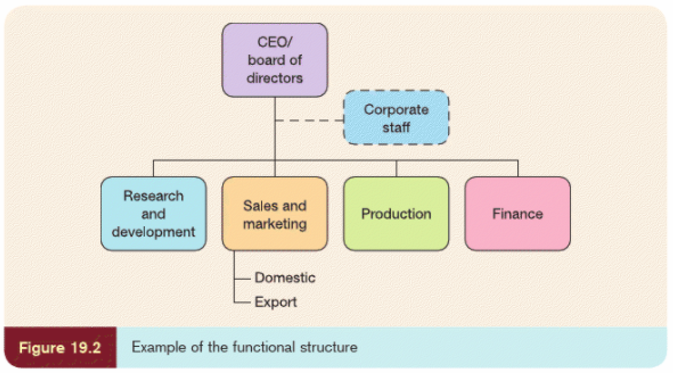
Coordination options – Product structure

Coordination options – Geographical str.
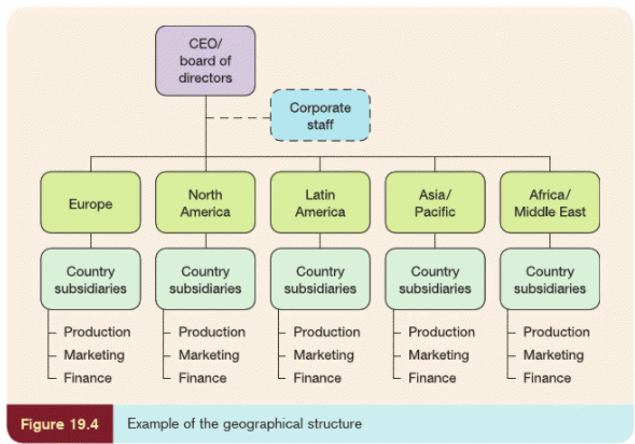
Control
How do we monitor, control and improve our plan?
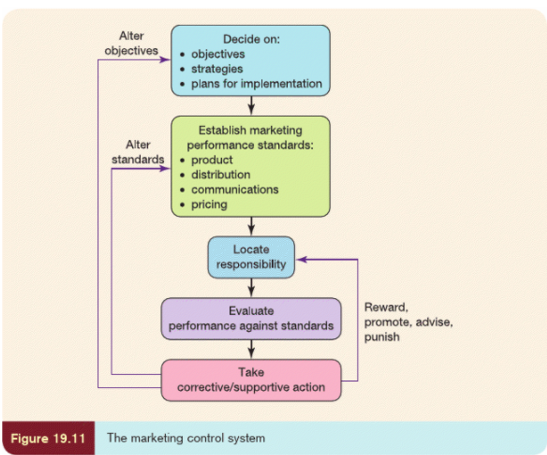
Established marketing performance standards are the most important stage in this figure. They are the Performance standard.
Spotting the early symptoms

Examples of synonyms
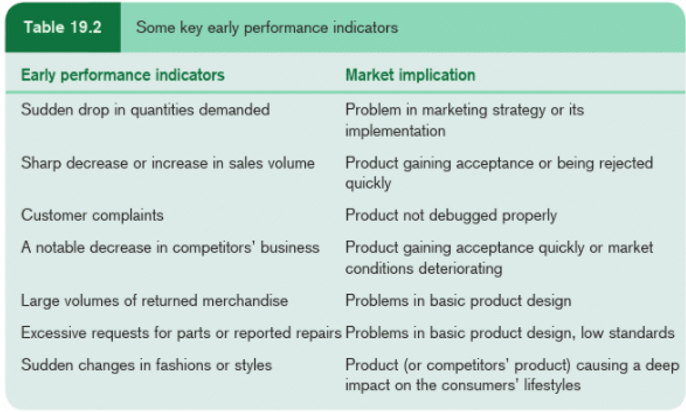
How to correct the bad symptoms
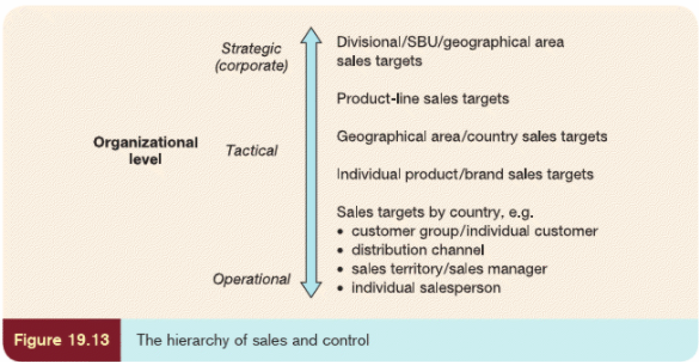
Marketing budget
General approach
Our plan, at some point, has to be translated into actual cost
This is our budget
Is the plan worth executing?
We need to have some kind of insight, based on assumptions, of course.
The golden number

International challenges
You might have the top-selling product in your country, a very profitable company, the most analytical team, all the budget you want, access to unique information, a great strategy, support from owners, top graduates in your rooster, etc….
BUT there is still a possibility of failing to enter a new market! If we don’t give a lot of attention to cultural issues.
Cultural map
